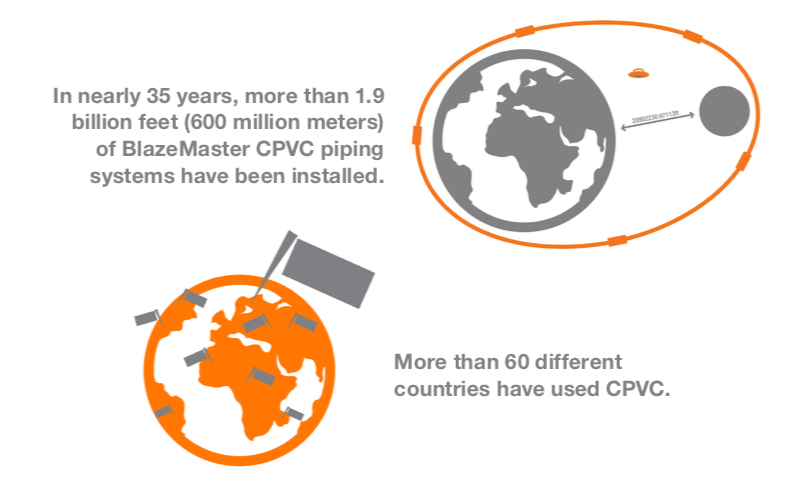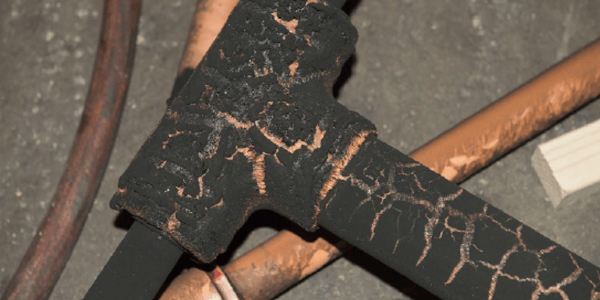Steel vs. BlazeMaster® Fire Protection Systems
Resource Downloads
Make the best choice for NFPA 13 light hazard fire sprinkler systems
For decades, steel piping systems have been the preferred material for fire sprinkler applications. Steel’s strength, durability and resistance to extreme heat make it a logical choice for building owners, facility managers and contractors.
However, material engineering capabilities have come a long way since steel established itself as the norm for fire protection systems. Specifically, chlorinated polyvinyl chloride (CPVC) has changed what you should expect of a sprinkler pipe and fitting material.
But, why should you trust the safety of your family, occupants and property to BlazeMaster® CPVC over a steel? We’ve detailed many reasons you should consider BlazeMaster CPVC for your next new construction project or building retrofit.
What is CPVC?
CPVC was invented by Lubrizol nearly 60 years ago. In 1984, Lubrizol introduced the material as an alternative to metal fire protection systems by launching BlazeMaster Fire Protection Systems. And our scientists continue to work with our manufacturing partners to enhance our compound formulations to meet the needs of the global fire protection market.
At a molecular level, CPVC is a thermoplastic made from a base PVC polymer that has been fortified with additional chlorine molecules. The extra chlorine, along with specialized additives, enables the material to reliably stand up to intense heat and pressure.
BlazeMaster CPVC won’t melt, drip, or spread a fire, unlike PVC and other thermoplastics. At the same time, the material maintains many of the same advantageous characteristics of thermoplastics, including
It’s these characteristics that have helped BlazeMaster Fire Protection Systems establish a proven track record of reliable performance. For more than 40 years, more than 2 billion feet (600 million meters) have been installed in more than 60 different countries.

How CPVC Compares to Steel
Flame Resistance
One of the primary advantages of BlazeMaster CPVC over other thermoplastics is its resistance to heat and fire. BlazeMaster CPVC maintains its structure and retains its internal water pressure when directly exposed to flame, ensuring sprinkler water will reach and extinguish a fire.
In fact, BlazeMaster CPVC piping forms a charring layer on the outside of the pipe, which then functions as a thermal barrier, reducing the conduction of heat. Flowing water also cools the inside of the pipe and prevents it from burning through.

BlazeMaster CPVC has achieved the best possible fire protection classification of a non-metal material—Bs1d0.
- Fire Behavior (B): BlazeMaster CPVC requires 60% oxygen in the atmosphere to sustain a flame. For reference, the Earth’s atmosphere is made up of 21% oxygen.
- Smoke Development (s1): The material limits smoke generation, which helps fire departments reach fires more quickly and lessens property damage.
- Flaming Droplets (d0): BlazeMaster CPVC does not melt in the way other plastics do, which eliminates the threat of flaming plastic droplets spreading a fire.
During a UL test, a fire plume between 698° and 901°F (370° and 483°C) came in direct contact with BlazeMaster CPVC piping for 10 minutes. The pipe continued to perform throughout the test.
Where BlazeMaster CPVC Stands Apart
Easy Installation
Steel piping is not easy to work with. For starters, steel is heavy. It requires special equipment to move around a job site and often two or more installers working in the same area. Its rigidity makes it difficult to maneuver through tight spaces and install in hard-to-reach areas. It also requires torches and loud threading machines to fabricate and join the system, which means costly hot-work permits, prefabrication, and vacating occupants from the premises.
Comparatively, BlazeMaster pipe and fittings systems weigh less, are flexible and are joined together using a quick, one-step solvent cement process. This translates to:
- Cleaner, quieter installation.
- One contractor can install an entire area.
- Any fabrication can easily be completed on the spot.
- Occupied buildings don’t have to be vacated.
For building owners and homeowners, BlazeMaster CPVC can speed up construction, lessen costs and limit disruption. For contractors, it means high-performing systems with less manpower, in fewer hours and without any specialized equipment.
“The many design alterations throughout construction made the use of BlazeMaster CPVC a more easily adaptable system than steel, which would have required refabbing in the field.”
—Chris Alexander, Vice President at SFS Security Fire Systems.
Cost Savings
Estimate up to 30% in cost savings when installing a BlazeMaster Fire Sprinkler System instead of a traditional all-steel solution, depending on the building structure and the amount used.
With BlazeMaster CPVC, installations are faster and easier to complete, saving time and resources. Depending on the size of the building and amount of material being used, this can mean substantial savings for both the installer and building owner.
In addition, BlazeMaster CPVC:
- Offers a lower, more stable material cost in comparison to steel.
- Does not require as much continual maintenance.
- May allow for smaller pipe diameters due to better hydraulics, helping to reduce overall material costs.
- Allows for quick and easy repairs.
Corrosion Resistance
Corrosion is an issue for any metallic piping system, including steel. Steel piping corrosion eats away at the interior of a pipe, creating more friction along the surface. The more friction, the slower the water flows in the event of an emergency.
Steel pipes also have to contend with scaling. Scaling happens when dissolved minerals drop out of the water and attach to the pipe wall, often near fittings and corners. As this scaling builds up and detaches, it can block the sprinkler head and limit or even prevent the flow of water entirely.
In comparison, BlazeMaster CPVC resists corrosion and scaling for up to 50 years of service life, even in salt air environments or with fluctuating water pH balances. BlazeMaster CPVC is also naturally immune to microbiologically influenced corrosion (MIC).
An article by Potter Electric Signal cited research by VdS, a German fire safety firm, which claimed that 73% of dry steel systems have significant corrosion issues at 12.5 years old and 35% of wet systems have significant corrosion issues after 25 years. However, these damages can occur “as soon as two years after installation.”
Reliable Hydraulic Performance
Reliable hydraulic performance ensures enough water reaches a fire, effectively extinguishing or suppressing it. A pipe’s surface has a direct impact on this—the rougher the surface, the more energy is needed to pump the water through the system.
The Hazen Williams formula was developed to help calculate this by measuring the friction and roughness along a pipe material’s surface. BlazeMaster CPVC has a Hazen-Williams C-Factor of
Additionally, the long-term smoothness of BlazeMaster CPVC can often mean smaller pipe sizes are required for the same level of flow security in a fire protection system. This can translate directly
Achieve Sustainability Goals
BlazeMaster pipe and fittings are less harmful to produce than steel pipe and have half the climate change impact. The BlazeMaster CPVC compound is manufactered in Louisville, Ky., and is made into pipe and fittings at our partners' factories in the USA and Canada. As a result, BlazeMaster fire sprinkler systems are a smart choice for supporting green building goals.


According to an ISO-compliant life-cycle assessment, BlazeMaster CPVC systems outperformed steel systems in 12 out of 13 environmental categories, including:
- Eutrophication.
- Aquatic ecotoxicity.
- Human toxicity.
- Terrestrial toxicity.
- Photochemical smog formation.
- Mineral depletion.
- Climate change.
- Water depletion.
Acidication .- Nonrenewable energy use.
- Fossil depletion.
- Ozone depletion.
- Renewable energy use.
Don't Choose Just Any CPVC
Not all orange pipe is the same. The quality and reliability of the piping material in your fire sprinkler system can make all the difference in the event of an emergency.
As the most specified non-metallic system in the world, BlazeMaster fire sprinkler systems exceed global performance and manufacturing standards for all CPVC systems. Its reliability, compatibility